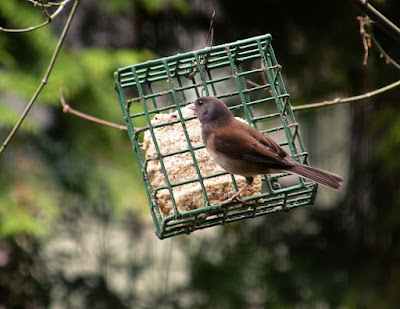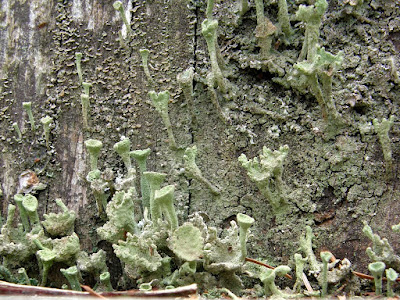I'm a stubborn sort (that's a polite way of putting it); in spite of the low light, the gloomy greys, I persist in trying to take photos of my birds, themselves mostly grey and dull browns. On rainy days, dull, overcast days, when the sun refuses even to warm the neighbours, there I am, aiming the lens at sparrows and juncos. Little Brown Birds. Little Brown Bouncy Birds.
Sometimes, I am pleasantly surprised; I get a recognizable shot.
So I happened to have the camera in my hand when this tiny, tiny wren dropped in to take a bath:
A blurry shot, but I'm happy; this is the first time a wren has come to visit.
A chickadee stopped at the edge of the bath for a couple of seconds while the wren splashed around. I was amazed at the difference in size. The wren, probably a winter wren, would measure between 4 and 4 1/2 inches, beak to upturned tail; the chickadee is not much bigger, at 4 3/4 to 5 3/4 inches. But that's a full 25 percent more. It showed.
Even tinier are the bushtits that come for suet: 3 3/4 to 4 inches, half of that tail feathers. A dozen or more swarm around the feeder, covering it like pins on a pincushion for a minute before they blow away into the trees.
A few stragglers, getting a final bite before they follow the rest of the flock to the next feeding station.
The junco is about twice the size of a bushtit; 5 to 6 1/4 inches. They take turns at the feeder; at most, one per side.
We do see an occasional flash of colour, here one moment, gone the next. A pair of red-breasted nuthatches (4 1/2 - 4 3/4") dashes over for sunflower seeds and suet; so do a few house finches (5 - 5 3/4"). Towhees search the ground under the suet feeder, picking up any crumbs the squirrels drop. Mostly, though, they stay in the deep shadows under the hedge, so that they're more recognizable by their size (7 -8 1/2") and their chicken-like scratching than by their colour.
And the last few days, a varied thrush, a brilliantly painted giant at 9 - 10", has joined the towhees. So far, any photos have been silhouettes, nothing more. He may as well be brown, too.


















































